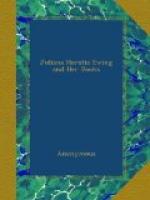If you know any that cannot afford them, give them in private.
Deal round the School Bibles to the Class for reference.
One’s chief temptation is to attempt too much. The great art is to make a good skeleton lesson of the leading points, and fill in afterwards.
Wait a long time for your answers.
Repeat the question as simply as possible, and keep saying—Now think—think. One generally gets it in time.
Lead up to your answer: thus—
Eleanor. “S. Augustine was a missionary Priest from—now answer all together?”
The whole Class. Rome.
Eleanor. “Now who was S. Augustine?—All together.”
The result probably will be that one or perhaps two will give the whole answer—and then you can say—
“That’s right. But I want you all to say it. Now all together. Who was S. Augustine?”
Then you will get it from all.
If you don’t mind it, the black board is often of great use. In this way—
[Sketch.] X represents the black board.
Suppose you have undertaken for the day’s lesson (a long one!) to begin at the question of whether we know the exact date of the first introduction of Christianity into England and to go on to S. Augustine’s Consecration. When you first arrive take your chalk and write—
S.
PAUL
and
draw a line;
----------------------------
then
ARLES
. . . . . 314
NICAEA
. . . . . 323
----------------------------
AUGUSTINE
ROME
ARCHBISHOP
OF CANTERBURY
597
----------------------------
Make them read everything as you write it, telling them the words till they are familiar. Then “lead up to” the written words in your questions and point with the stick, so that they will finish the answer by reading it all together. Thus—“The Council of —— (stick to Aries) in the year —— (stick to 314).”
When you are teaching a thing, make them answer all together. When you are examining what you have taught before, let those answer who can.
Of course my notes give no idea of the way one teaches, I mean of course one has perpetually to use familiar examples, and go back and back—and into things.
Put the more backward children behind the others, and never let any of the front row answer till the back row have tried.




